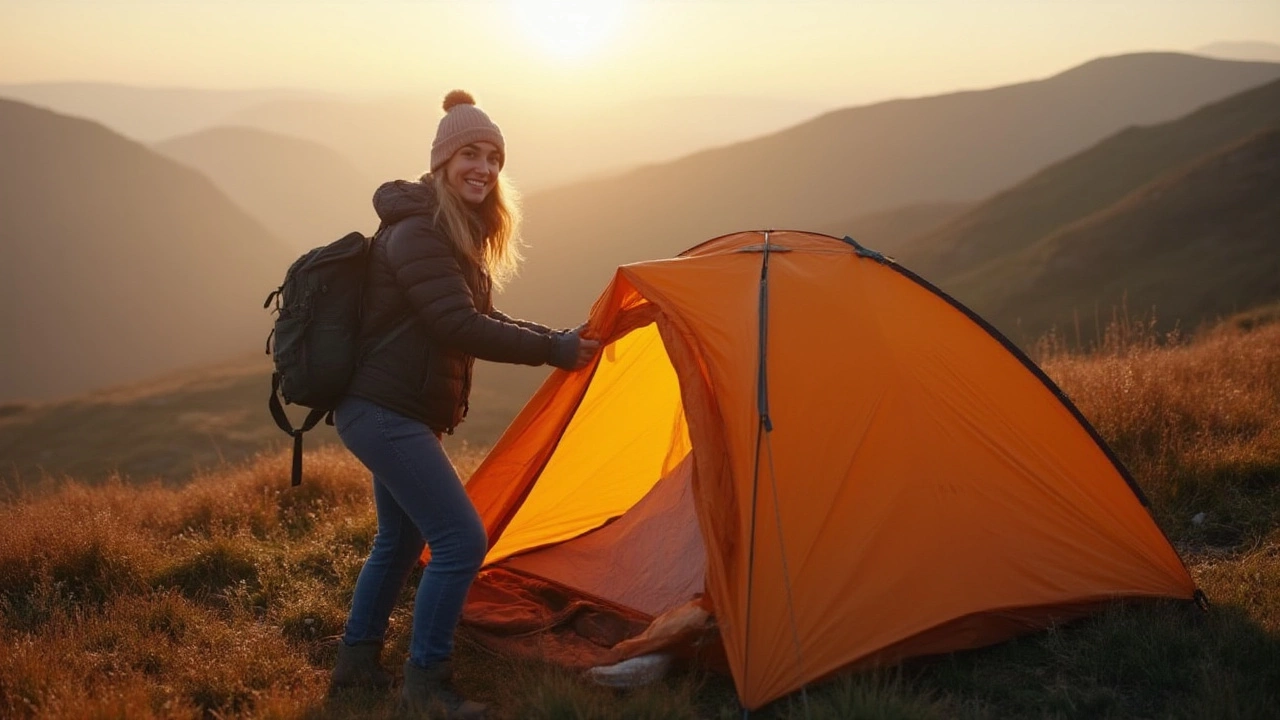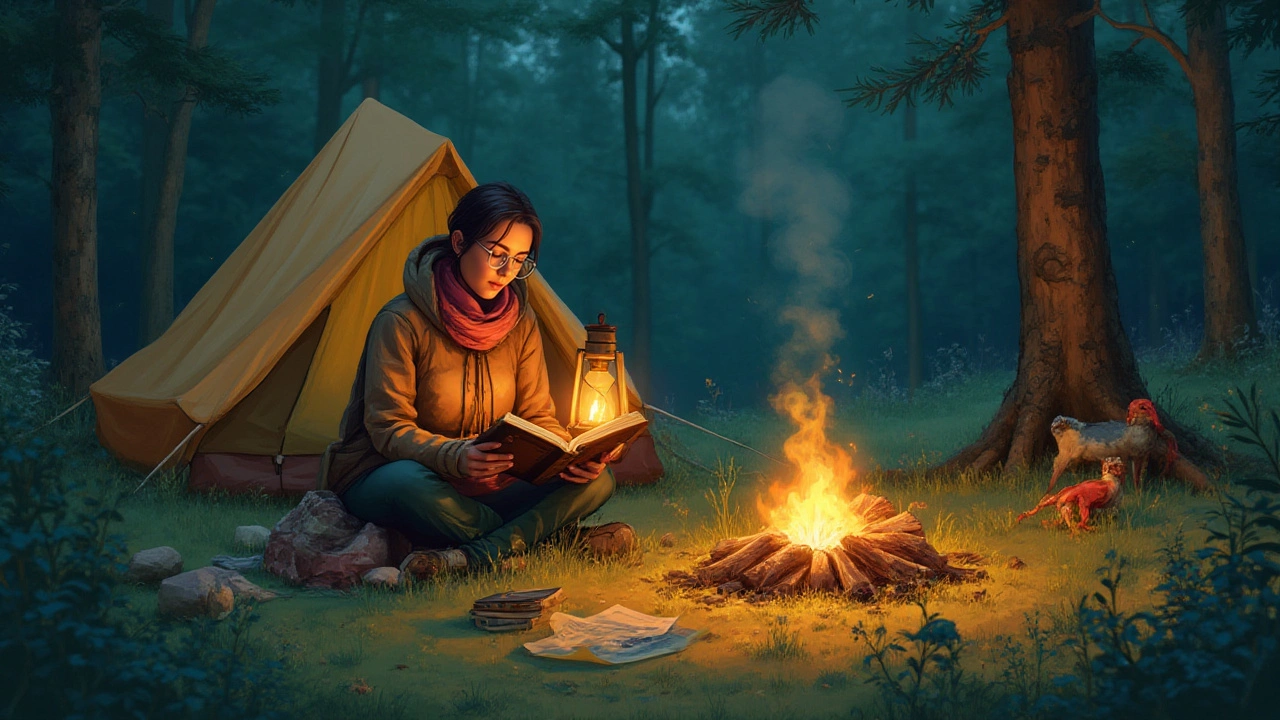Is Solo Camping Safe for Women? Facts, Advice, and Real-Life Tips
 Jul, 6 2025
Jul, 6 2025
Picture this: A single tent, a crackling fire, the forest canopy overhead, and not a soul for miles. For some, that's bliss. For others, it's pure anxiety. It’s no secret that the idea of a woman camping alone stirs up all kinds of emotions, both for women themselves and the people around them. Fears of wild animals, unreliable strangers, or just plain old loneliness pop up instantly. But headlines aren’t always the full story. Statistically, most wilderness crime involves theft from vehicles at trailheads, not people getting ambushed in their tents. In fact, if you dig, you’ll find that the outdoors—despite the horror stories floating around on the internet—are statistically safer for solo women than many city streets.
The Real Risks: What Does the Data Say?
Let’s address the big question: Are solo women in danger when camping alone? The U.S. National Park Service, which keeps careful track of incidents across millions of campers annually, reports that only a tiny percentage of crimes on public lands target solo female visitors. According to a 2022 NPS report, violent crime in national parks occurs at a rate of 0.18 per 100,000 visitors. That's far lower than comparable urban or even suburban figures. To put that in context, you’re much more likely to have your purse stolen on a city bus or get into a car fender-bender than to run into trouble while backpacking in Yellowstone.
Wildlife is another big concern, but here’s the deal: There are far fewer animal attacks in U.S. parks than people might think. Bears are dangerous only if you surprise them or mess with their food. According to a study published in Human–Wildlife Interactions, there’s about a 1 in 2.7 million chance you'll be injured by a bear in Yosemite. More people slip in their showers than get attacked by wild animals. Still, it's smart to know your area—take black bears and grizzlies seriously, and learn basic bear safety if camping where they roam.
But let’s not sugarcoat things. While rare, incidents do happen. Theft from unattended campsites is much more common than violent crime, and unwanted attention or harassment from other campers can occur, especially at busier campgrounds. These are avoidable risks, not inevitabilities. Women’s real-life experiences reflect this mix: most solo campers report the worst thing they’ve faced is a raccoon stealing snacks or an over-curious fellow camper.
According to Backpacker magazine’s "Women Who Hike Alone" survey, conducted in mid-2023 with 1,800 solo female hikers, 94% reported no negative encounters with humans or wildlife on the trail. This doesn’t erase the fear, but facts give you a baseline: the actual risk is much lower than most assume.
Here’s a quick look at some numbers:
| Incident Type | Annual Rate per 100,000 Park Visitors |
|---|---|
| Theft from Campsites | 3.8 |
| Harassment by Strangers | 0.75 |
| Serious Physical Assault | 0.12 |
| Wildlife Attack (Bear) | 0.02 |
So why all the hype? It’s the same reason we worry about rare plane crashes but don’t stress about highway driving. Human brains just aren’t wired for accurate risk assessment, especially when unfamiliar settings are involved. For most solo female campers, the wilderness offers space, challenge, and peace—not just lurking threats.
Solo Female Campers Speak: Stories from the Wild
Forget the stereotypes of helpless damsels clinging to pepper spray. Solo women in the outdoors are among the most capable, self-sufficient, and prepared campers out there. Ask anyone who’s tried it—solo camping for women is usually less about "surviving danger" and more about mastering logistics and personal fears.
Sara Underwood, a travel writer who’s covered solo camping on five continents, told Outdoor Life in January 2024: "The toughest hurdle isn’t safety, it’s confidence. People (mostly men) give you side eyes, but that has nothing to do with your skills or what’s actually likely to happen."
On social media, thousands of women swap tips, dish honest stories, and share boosts of encouragement. Some learned their lessons the hard way: packing too much, wrestling with bad weather, or choosing noisy campsites. But fears of stalking, assault, or animal attack almost always turn out to be just that—fears, not memories.
- Solo backpacker Elise shares on Instagram: "People always worry about men. For me, critters and storms are more of a headache."
- Adventure blogger Kendra says: "After my third solo night, I slept like a rock. I realized I feared what I didn’t understand, not what was actually there."
- Outdoors educator Janice admits: "The first time, I felt naked without backup, but you adapt and each time gets easier."
Sharing stories matters. It chips away at the old myth that women are ill-equipped for remote adventure. The truth is, a woman hiking alone is usually better prepared and more vigilant than most dudes with GoPros.
Mental hurdles come with the territory, especially if family or friends fuel your doubts. A little preparation and a lot of self-belief go further than any fancy hiking gadget. And with groups like "Women Who Explore" and "Girls Who Hike" booming, there’s a whole tribe of women who've got your back—whether you want company or just advice.
“The best way to gain confidence camping solo is to start small, build up skills, and realize the woods aren’t out to get you,” says Whitney LaRuffa, Leave No Trace Master Educator, in an REI interview from August 2023.
With experience, the "what ifs" fade, replaced by actual memories: waking up to sunrise, listening to owls at night, and feeling that rare, good kind of fear—the excitement of stretching your comfort zone.

Smart Prevention: Realistic Tips for Safer Solo Camping
No one wants to be the cautionary tale. That’s why it makes sense to prepare, not panic. A few smart habits can turn a potentially stressful trip into an empowering one. If you’re thinking about camping by yourself, here’s what’s proven to work—and what actually matters.
- Plan Your Campsite Wisely: Avoid isolated pull-offs where you’re out of sight, but also give busy party campgrounds a miss—drunk neighbors cause more trouble than strangers in the woods. Aim for areas vetted by other female campers, and check reviews on apps like The Dyrt or iOverlander. State and national park campgrounds with hosts nearby offer a solid middle ground.
- Share Your Plans: Always text a friend or family member your itinerary and expected check-in times. Free apps like "Glympse" or “Garmin inReach” if you’re going remote, let you update locations even with no cell service.
- Trust Your Gut: If anything feels off—another camper acting weird, odd noises, or just a sense of unease—pack up and move. Don't second guess your instincts. You’re better off being overly cautious than regretting it later.
- Keep a Low Profile: Don’t post your exact location in real time. Share the beautiful sunrise after you’ve already moved on. Especially if you have public social media.
- Know Basic Self-Defense: Most women never need it, but watching some YouTube videos, taking a local class, or carrying pepper spray (legal in most park areas) gives peace of mind—even though odds are, you’ll never reach for it.
- Lock Up Valuables: Use backpacker habits—stash valuables out of sight (or better yet, don’t bring them). Small padlocks or portable safes work if you leave base camp for a hike.
- Set Up Camp Before Dark: This gives you time to get a lay of the land, meet neighboring campers if you want, and avoid last-minute stress. Arriving during daylight also sends the right signal: you’re organized and aware.
- Bring Comfort Items: A good headlamp, first aid kit, and something familiar, like a journal or your favorite snacks. The psychological boost matters as much as the “tactical” gear.
One thing stands out: the best weapon is preparation, not paranoia. Being proactive—choosing smart campsites, keeping a clear head, and planning communication—matters more and does more for confidence than any Hollywood scenario. That’s why so many veteran solo campers are evangelists for self-reliance.
The Upside: Freedom, Strength, and Why It’s Worth It
Sure, the safety question hangs over every conversation about women alone in the wild. But step back and the reasons to try it far outweigh the reasons to stay home. Women who solo camp talk about something that doesn’t translate on paper: the incredible boost you get from facing down your nerves and coming through just fine.
There’s freedom in pulling off the highway, pitching camp, building a fire, and watching the world quiet down—on your own schedule, your own terms. That independence can transform you. A 2023 Stanford study on women and outdoor adventure found that solo campers reported higher boosts to self-confidence, resilience, and overall happiness than those who only went with groups. The simple act of handling challenges alone—setting up a tent in rain, shooing away skunks, or finding your own route—gives a kind of personal power city life rarely delivers.
For women who carry the usual weight of social expectations (or anxiety about saying “no” to a group), the solo trip is a way to reset. You have time to think, breath, and discover what you love about wild places—without group compromise. And, as thousands of campers post every week, it’s more about the adventure than the danger. The vast majority return with funny stories about bugs or midnight bathroom trips, not tales of disaster.
So, is it safe for a woman to camp alone? If you plan, prepare, and trust yourself, it’s as safe as most activities—and way more rewarding than staying in your comfort zone. The wild isn’t out to get you. In fact, it’s more likely to remind you just how strong, clever, and independent you can be.